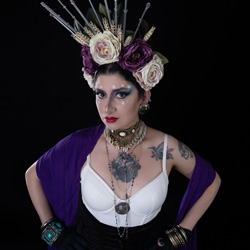 Ten Questions, Ten Minutes with Cabrakaän
Ten Questions, Ten Minutes with Cabrakaän
Now based in Canada but tracing their roots back to Mexico, Cabrakaän perhaps uniquely blend their influences to create symphonic folk metal infused with indigenous pre-Hispanic Mexican culture and black metal overtones. The result is an outpouring of atmospheric, exciting and diverse music, exemplified by their new album ‘Aztlán’. So, let’s put the founder members Pat Cuikani and Marko Cipäktli in the Ten Questions, Ten Minutes hot seat.
Q1. Can you give me a quick history of the band, please, and confirm the current line-up?
Marko: “Our band started with Pat and me. I started out with the intention of assembling a death metal band. At the time, I think around 2011, I owned a recording studio back home in Mexico. Pat came to my studio as part of another band she was part of. We found that we had a lot of similar musical goals and overlapping creative ideas. One day, she told me, ‘I’ve always wanted to do something pre-hispanic.’ With that, it was a part of our musical history that really defined who we are as a band today.
“Early on, we met Ramón Estrada, who was in the band for a short (but important) time. He had a great interest in European folk metal and, even though he’s not an active member anymore, he made a big impact on the evolution of our sound. We met Paolo Belmar, our rhythm guitarist from 2016-2022, back in Mexico through mutual friends. He and his family moved to Canada, and so we began to learn about the Canadian metal scene. When we were invited to perform at Metalocalypstick metal festival in British Columbia in 2016, we met Alex Navarro, our current lead guitarist. I remember that we asked him to join us for the festival a month before we were scheduled to perform, and he learned our material in record time. He’s been part of us since then. We met David Saldarriaga last year through Alex when we needed a bass guitarist for our studio recordings, and as it turned out he also contributed classical guitar elements that brought our songs to another level. We met our newest member, Brendan Wilkinson, early this year. He’s an Australian who recently moved to Canada, and we clicked right away.
So, as of 2023, our full line-up is:
Pat Cuikani – lead vocals, ocarinas, conch, flutes
Alex Navarro – lead guitar
Brendan Wilkinson – rhythm guitar
David Saldarriaga Tobón – bass guitar, classical guitar
And Me! Marko Cipäktli – drums, percussion, guttural vocals.”
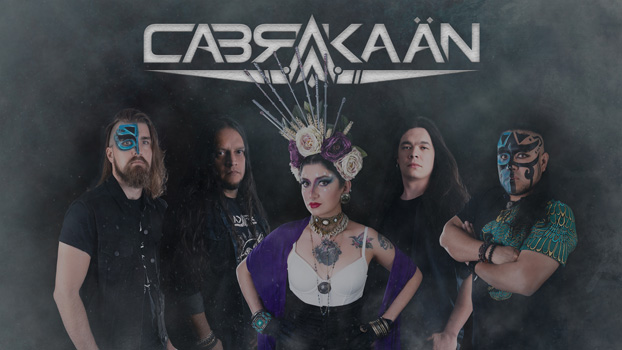
Q2. And how did the band’s name Cabrakaän come about? Is there a meaning behind it?
Pat: “Marko and I were looking for a name for the band, something that sounded good and also had a beautiful and powerful meaning, and it took us maybe a couple of months to find the perfect one. Our band name, ‘Cabrakaän’, is an adaptation from the Mayan god, Cabrakan (alternatively spelled Caprakan). He was the god of earthquakes and mountains and, of course, that makes it a powerful symbolism in music and metal. It also makes a statement that we have a strong mythology in our culture, just as the Norse gods we read about in Viking history.”
Marko: “Cabrakan was known for being very powerful. According to myth, his power brought out his arrogance and vanity. We wanted to leave this part behind and carry the name forward to symbolize power and strength because it represents exactly what we want to do with our music.”
Q3. Congratulations on an extremely interesting and diverse album. What did you set out to achieve when you wrote and recorded ‘Aztlán’?
Marko: “Thank you very much! Our band name represents more than just a Mayan god. It represents the message we want to send as a band: our part of the world has history too. ‘Aztlán’ itself was about telling the story of how we became who and what we are as Mexicans today. I wanted to tell the story of our ancestors, the impact of the Spanish Conquest, and how it had a massive influence on our identities. I also wanted to touch on how we evolved into what we are now, because even the darkest parts of our history combined to form who we are. Doing all of this through the medium of metal has allowed us to have a full freedom of expression to tell our stories to a wider audience throughout the world.
“Mexican culture is way more than just tequila and mariachi. It’s more than pyramids. It’s a huge combination of elements that isn’t limited to one perspective or specific region of Mexico. All of that was part of what we wanted to tell the world. I decided to do this because I wanted the world to look toward Mexico and see that we have just as complex and interesting a history as the histories depicted in European forms of folk metal.
“Aztlán, as a concept, is the ancestral homeland of Aztec people. It doesn’t have a geographic location, and it’s something that has been used to reinforce our cultural roots. We named our album this because it metaphorically represents our origin, especially since we live now in Canada, and we’re going back to our roots through this music. The main difference with Aztlán and its predecessors [‘Songs From Anahuac’ (2014) and ‘Cem Anahuac My Home’ (2019)] is that we achieved a ‘bigger’ sound by focusing more on using symphonic elements. We have also evolved into using more folkloric themes instead of pre-Hispanic ones. For us, folklore represents more than what our civilization was like before colonisation – it represents everything that’s happened from the beginning to present day, so it’s even more personal than before.”
Pat: “It seems to me to be a much more mature and somewhat different sound, taking into account that we have some new members who have added a very special touch, however, it maintains its essence and heart.”
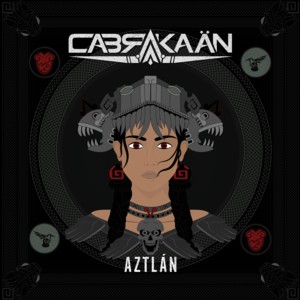
Q4. The fusion you create of symphonic, black and folk metal is intriguing – very accessible, but obviously very skilfully written and played. How easy is it to blend the elements that create your sound?
Marko: “It was definitely a challenge to blend all of the elements we used. The best way I can describe the process was by ‘layering’ elements. We usually start with a main motive (like a melodic line), and from there, it’s about finding the elements that fit. That includes the guitar riffs, orchestral arrangements, and so on. The arrangement is what truly brings out the character and atmosphere of a song. The orchestration also is the part that starts to bring out the emotion, allowing us to find the right elements to complement it. It’s very iterative, though. Once the main ideas are there, we usually tweak them. For example, if an instrument’s note or chord ends up not fitting in with the orchestration, then we adapt it until it fits. Sometimes the orchestration changes if it doesn’t harmonically fit with the rest.
“As for the traditional instruments we used, they came in the last stage right before the vocals. Before vocals come the percussion, ocarinas, and flutes. It’s challenging musically speaking to find the right spot where they can really stand out as we want them to. We’re not definitively pre-Hispanic metal as some other Mexican bands, so we’re not focused on it from the beginning stages. At the same time, it’s very important for us that these elements are part of it, and that they stand out and people can appreciate them. Just as I’m interested in knowing more about instruments I’ve never heard in my life from other bands, adding these elements helps draw attention to our culture and who we are.”
Q5. What inspires your lyrics? Where does your inspiration come from?
Pat: “Without a doubt, the diverse, vast and wonderful history of Mexico, in particular on this album we are inspired by ancient Mexico. There are so many stories to tell, and these are just a tiny part of them.”
Marko: “It’s both the historical and cultural part of Mexico - that’s a huge inspiration for us. Lyrics also come from our real life experiences, the fact that we’re not in our home country. Being away from home makes us more interested in connecting with our roots. Political and economic parts of Mexico are also inspiration – Malintzin (on Aztlán), for example, is based on a historical figure of the same name. She was an indigenous woman who helped the Spaniards during the conquest with things like interpretation, and so she was seen as a traitor by her own people. Over time, her name evolved into the word ‘malinche’, then ‘malinchismo’, which now is a term for feeling ashamed of your own culture. We use this word in Mexico even today. It’s something that’s happened since colonialism, being ashamed of who we are – to have indigenous blood. My approach was more from the historic perspective, but Pat adapted the lyrics to have a more modern connotation because of personal experiences she’d had.
“That’s just one example of how we approach lyrics, but they’re always connected to our culture either through our country’s history, mythology, or personal experiences.”
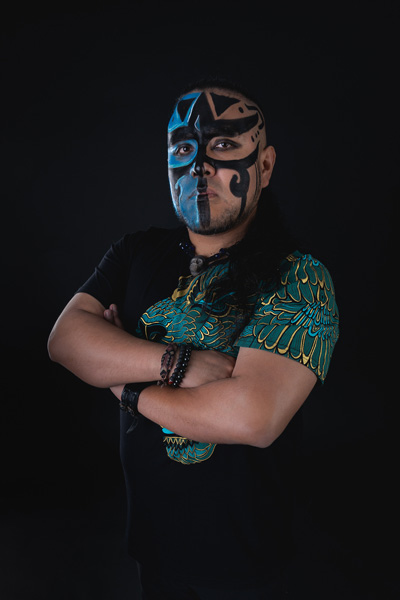
Q6. What album (or albums) made you think “I want to be a musician; I want to do that”?
Pat: “For me, it was the operas that were heard at home when I was little, like ‘Madama Butterfly’, ‘Carmen’ and ‘Elixir De Amore’. My mother was a singer, and I was already exposed to so many classical and folk styles of music.”
Marko: “Metallica’s ‘And Justice for All’, Megadeth’s ‘Rust In Peace’, Nightwish’s ‘Once’, Dream Theater’s ‘Train Of Thought’, and Amon Amarth ‘Versus The World’ were all big sources of inspiration for me. Metallica and Megadeth were what got me into drumming, and the rest were what inspired me to form a band later on. They are all still big influences for me.”
Q7. What are your strengths as a band?
Pat: “The brotherhood, the love for music, the love for our roots and for our Mexico and without a doubt the love for the band. Despite being far away, we remain united through Cabrakaän. Even though we’re not all from the same country, I think we all identify with the history and roots of the music.”
Marko: “We’re not all Mexicans, but most of us share a history of colonialism in our culture. We have the same love for our past and roots. We’re also all experienced musicians, so we have a good connection and mindset with each other.”
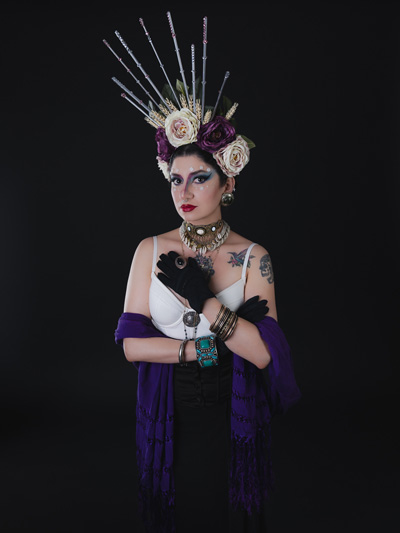
Q8. What’s next for the band?
Pat: “Of course, the album release [17 November] is coming up quickly. From there, we’re making plans to perform and go on tour so that more people know our work. We’re also already thinking about and planning to work on our new compositions.”
Q9. What film do you think ‘Aztlán’’ could be the soundtrack to?
Marko: “The first one that comes to mind is a film called ‘The Other Conquest’ (‘La Otra Conquista’). It was actually a bit of an inspiration for our track ‘Luces Y Sombras’. It’s about the impact of Spanish colonization, including a lasting religious and ideological conquest that can still be felt and seen today. The movie explores how difficult it was for Mexican civilizations to adapt to a completely new and unfamiliar system after a lifetime of living with their own belief systems, traditions, languages, and culture. The movie starts with the Spaniards’ arrival, when they were welcomed and initially trusted before they began a years-long violent conquest. I’m not sure if ‘Aztlán’ would be the soundtrack for it, but it was definitely inspiration for us.
Q.10 If you drove an ice cream van, what tune would it play?
Pat: “I would play ‘La Cigarra’!” [from their album; also a 1987 song by Linda Ronstadt]
Marko: “From our own songs, I would play ‘Cipactli’. Maybe I’d also play ‘Mariachi Loco’. I think it’s a public domain song, and many mariachi bands play it. I’m sure it would get people in the mood for some ice cream!”
Video clips:
Fuego - https://www.youtube.com/watch?v=5l0SfGbWP2I
Mictlán - https://www.youtube.com/watch?v=mPLYXJBGXGI
La Cigarra - https://www.youtube.com/watch?v=Bspm_V-wa3o
© John Tucker November 2023 / All photos by Angela Ambrose
